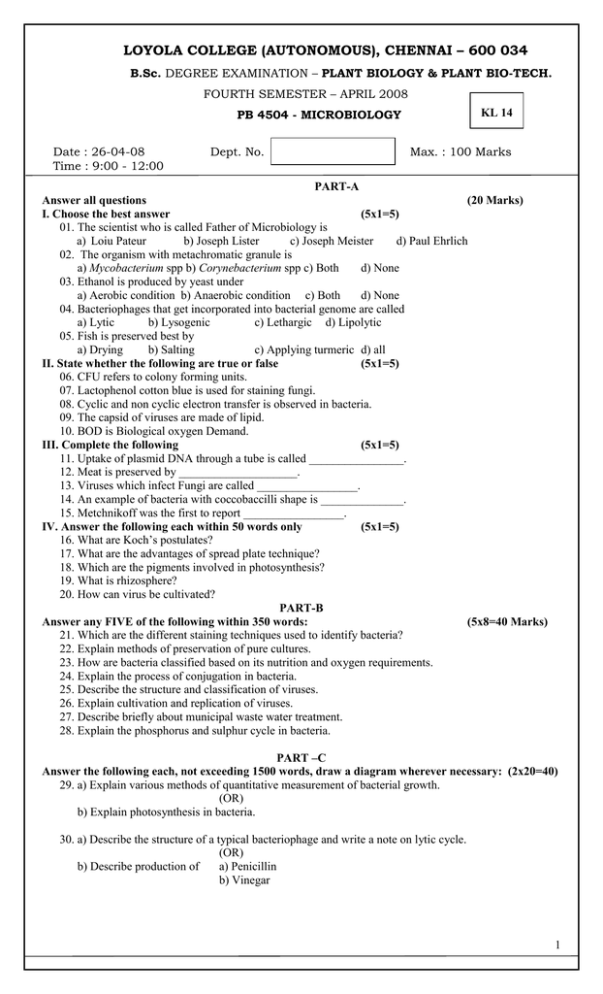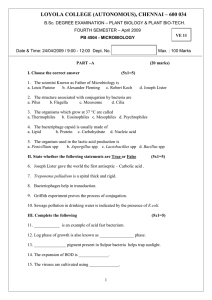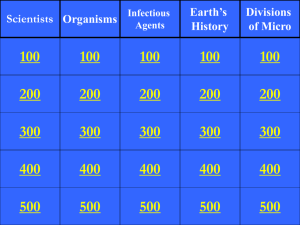LOYOLA COLLEGE (AUTONOMOUS), CHENNAI – 600 034
advertisement

LOYOLA COLLEGE (AUTONOMOUS), CHENNAI – 600 034 B.Sc. DEGREE EXAMINATION – PLANT BIOLOGY & PLANT BIO-TECH. FOURTH SEMESTER – APRIL 2008 PB 4504 - MICROBIOLOGY Date : 26-04-08 Time : 9:00 - 12:00 Dept. No. KL 14 Max. : 100 Marks PART-A Answer all questions (20 Marks) I. Choose the best answer (5x1=5) 01. The scientist who is called Father of Microbiology is a) Loiu Pateur b) Joseph Lister c) Joseph Meister d) Paul Ehrlich 02. The organism with metachromatic granule is a) Mycobacterium spp b) Corynebacterium spp c) Both d) None 03. Ethanol is produced by yeast under a) Aerobic condition b) Anaerobic condition c) Both d) None 04. Bacteriophages that get incorporated into bacterial genome are called a) Lytic b) Lysogenic c) Lethargic d) Lipolytic 05. Fish is preserved best by a) Drying b) Salting c) Applying turmeric d) all II. State whether the following are true or false (5x1=5) 06. CFU refers to colony forming units. 07. Lactophenol cotton blue is used for staining fungi. 08. Cyclic and non cyclic electron transfer is observed in bacteria. 09. The capsid of viruses are made of lipid. 10. BOD is Biological oxygen Demand. III. Complete the following (5x1=5) 11. Uptake of plasmid DNA through a tube is called ________________. 12. Meat is preserved by ____________________. 13. Viruses which infect Fungi are called _________________. 14. An example of bacteria with coccobaccilli shape is ______________. 15. Metchnikoff was the first to report _________________. IV. Answer the following each within 50 words only (5x1=5) 16. What are Koch’s postulates? 17. What are the advantages of spread plate technique? 18. Which are the pigments involved in photosynthesis? 19. What is rhizosphere? 20. How can virus be cultivated? PART-B Answer any FIVE of the following within 350 words: (5x8=40 Marks) 21. Which are the different staining techniques used to identify bacteria? 22. Explain methods of preservation of pure cultures. 23. How are bacteria classified based on its nutrition and oxygen requirements. 24. Explain the process of conjugation in bacteria. 25. Describe the structure and classification of viruses. 26. Explain cultivation and replication of viruses. 27. Describe briefly about municipal waste water treatment. 28. Explain the phosphorus and sulphur cycle in bacteria. PART –C Answer the following each, not exceeding 1500 words, draw a diagram wherever necessary: (2x20=40) 29. a) Explain various methods of quantitative measurement of bacterial growth. (OR) b) Explain photosynthesis in bacteria. 30. a) Describe the structure of a typical bacteriophage and write a note on lytic cycle. (OR) b) Describe production of a) Penicillin b) Vinegar 1







